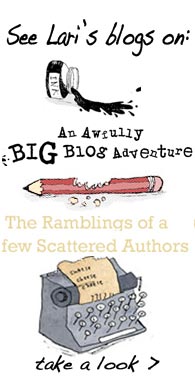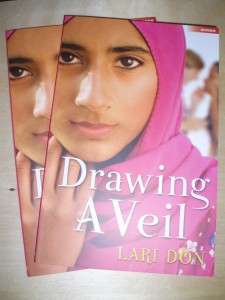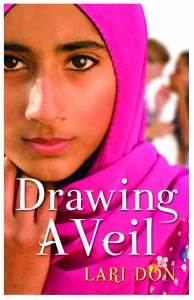| Feb 16 |
Archive for the 'Research' CategoryDrawing A Veil – Writing Right Outside Your Comfort ZoneMy new novella, Drawing a Veil, is about a girl who decides to wear a headscarf to school, and her friends’ and classmates’ reaction to that decision. I’m fascinated by the idea of choice, and how we deal with the awkward fact that if we support people’s right to make free choices, then we also have to support them when they make a choice we may not agree with. Writing this book did make me feel uncomfortable at times, and I know it made a few of my feminist friends uncomfortable too. So is it a good idea to write about something which makes you feel uncomfortable or challenges the comfy assumptions you don’t question often enough? If I only wrote about decisions which I agreed with, if I only wrote stories which I felt happy and warm and cosy writing, then I probably wouldn’t write anything worth reading. (A lot of Helen’s risk-taking in the First Aid series, for example, makes me VERY nervous as a mum!) So, even though I’m an atheist, who would never cover any bit of me up to please a god I don’t believe in, I realised that if I want the right NOT to wear a headscarf, then I also have to stand up for other people’s right to wear headscarves if that’s what they want. (And of course, any girl’s, or any woman’s, right not to cover up if she doesn’t want to.) Also I think there’s an assumption that all girls in veils or scarves are shy, unsure of themselves, hiding themselves. But when I talk to kids in schools about imagination and creativity, I see absolutely no difference in their levels of confidence or self esteem, whatever the girls are wearing on their heads. So I really wanted to write about a girl in a headscarf who stands up for herself, who takes part in an argument, a fight and a chase (because action is what I enjoy writing!) This isn’t the first time I’ve written about subjects which make me uncomfortable or make me question my own assumptions. In both Wolf Notes and Rocking Horse War, I’ve written about hunting and hunters, even though I’ve been a strict vegetarian since I was 14. So writing about wolves hunting deer, or girls tracking deer (poor deer are victims in a few of my books!) made me question my own reasons for being vegetarian. When I was researching wolves and how hunting led to their social networks and their intelligence, I seriously considered becoming an omnivore again, because that’s what humans evolved to be. But after reflection, I decided my reasons for being vegetarian were more than just a long lasting fit of teenage pique, so I am still a proud veggie. But the point is that I write about characters who believe very different things from me, and I allow those characters and their stories to make me examine my own beliefs. I think that’s a very good thing. For the characters, for the stories and for me. And how did spending time with Amina in Drawing a Veil change my comfy assumptions? Writing about this confident girl and her decisions made me realise that a freely taken decision to wear a headscarf can be a positive assertion of identity, rather than a passive adherence to family or religious pressure. So – what beliefs or assumptions of yours could do with being taken out and examined by stories, characters and tough questions? |
| Nov 13 |
Archive for the 'Research' CategoryLetting readers influence the storyMy writing is not a solitary occupation. I do imagine and scribble and type the stories on my own. But I often do it in busy noisy sociable places. Not sitting-in-a-café-nibbling-cake or gazing-at-inspiring-art sort of places. Even though that was what I’d hoped a writer’s life was like, I never seem to have time! No, I do lots of writing on trains and buses on the way to book festivals or school visits. And I do a lot of writing outside my kids’ afterschool classes (I was writing a story about dancing giants outside my daughter’s ballet class recently, and I swear the cute little girls in the hall were making more noise than the giants in my head). So I’m often writing surrounded by people and noise. And I like to involve other people in my writing. I work closely with various editors, and they sometimes point out plot problems and suggest solutions. (I then come up with my own completely different solutions, just to show that I’m my own person, but I always fix the problem.) But all writers have to work with their editors. I often involve other people too. My own kids have been involved in brainstorming titles and character names (often at bus stops.) And I sometimes read whatever I’ve been writing on the train to whatever children I’m visiting: What do you think? I’ll ask. And I will listen to what they say, often scribbling it down on the ms. But what I’m really looking for is whether they gasp at the right bits… (because then I know it’s working!) I’ve had research help from readers too: a class in Inverkip Primary did lots of selkie research for Storm Singing. But this year, I’ve taken involving others in my writing a bit further. This year my publishers Floris ran a competition for readers to suggest a location for the fourth and final First Aid book. (I had already used most of the bits of Scotland that I knew, and I was hoping for new and exciting ideas.) So we offered as the prize the promise that whatever location won would definitely be in the finished book. That promise was a HUGE risk! What if everyone had suggested impossible, boring or clichéd places? What if I’d committed myself to setting the book in a supermarket car park? I was putting the whole future of the book into the hands of the readers. But I needn’t have worried. We got hundreds of ideas, and they were all FANTASTIC! I could write a lifetime’s worth of adventures based on all those wonderful locations. So what location won? I’m not telling. Not yet. We’ll announce it on Wednesday. So watch this space! |
| Nov 01 |
Archive for the 'Research' CategoryAsking the landscape some questionsI had an all-day adventure at the end of last week, researching a hill for the first quest in the Fourth First Aid book. When I go to a location, I don’t just turn up thinking: oooh, I hope this is a pretty place! I put a lot of work into picking potential locations, so I will have read books of local legends, googled the area, and bought a really detailed Ordnance Survey map. If I can find so much out without leaving my desk, why do I bother to go? Well, I realised when I was preparing for my trip on Thursday (no, I’m not telling you where I went – that would give too much away!) that I wanted to ask the landscape some questions. Like I was interviewing it, for the job of being my location. My questions on Thursday included: Are there sheep nearby? Is there somewhere to park a dragon? And could a horse get up that hill? The answers aren’t always what I’d expect. From the map, I thought a nearby quarry would be a good place to park a dragon. But when I got there, there was a farmhouse really close, which put me off poking about (I don’t like wandering into people’s gardens, especially if they have big dogs) and if it put me off, it would certainly be too close to human habitation for Sapphire. So I had to keep asking the landscape: is there ANYWHERE to park a dragon round here? But it isn’t just parking spaces. I need to find the right places for escapes, fights, magic and chases. However, I never know exactly what I want to happen in a story , and I’m always open to the landscape inspiring me, so I have to look very hard at what’s there, not just at what I expected to be there. I can take a very long time to walk up a hill when I’m researching, because I have to stop walking every time I want to scribble something, or else I might put my foot down a rabbit hole, or slip on some sheep jobbie. I found a lot of sheep jobbie on Thursday. I wonder if it might come in handy. As a weapon? Who knows… And I try to go on the journey with the characters, seeing it the way they would. For example, a barbed wire fence along the path didn’t bother Helen or me, but it really bothered Lee, because faeries don’t like iron. So I had to see the landscape not just through my eyes, but theirs too. So – that’s how I interview a landscape. Not the sanest thing to do on a sunny Thursday in October, but lots of fun, very muddy, and essential to the first quest. Now, where am I going for the second quest? |
| Oct 25 |
Archive for the 'Research' CategoryThe pictures in my head vs the pictures on the pageI’ve seen covers or illustrations for three of next year’s books in the last week or two, and it’s always scary. When I get emails from editors with attachments lurking at the top, I always pause and take a deep breath before opening them. I am excited, but also a bit nervous. I see stories in my head when I’m writing them. I see the tortoise crossing the savannah with determination on his face. I see the surprise on a teenager’s face when her best friend turns up in a severe headscarf. I see the confusion on a toddler’s face when she’s given a bowl of icecream topped with… well, I’ll not give that away. I see their faces, I hear their voices, and I know their thoughts. So it’s really strange to see someone else’s pictures of them. Because the characters are never exactly the way I imagined them. The pictures are usually fabulous, and bring the story to life, and that’s wonderful. But how could they possibly be exactly how I imagine them? So when I get these pictures and the editor asks for my comments I have to try very hard not to go: ‘AAAARGH but that’s not right because Ellie has freckles and her teeth are slightly squint and she wears hoop earrings and…’ Because none of that is important in the story. It’s just how I saw her when I met her in my head. I have to try look at the pictures not as the unique illustration of the perfect story that I saw in my head, but as one of many possible illustrations of the actual story that I managed to put on the page. I need to check whether the pictures help tell the story, and not expect them to be a telepathic rendering of my own thoughts. But I’ve noticed something strange about the books that have already been published. Even though the characters on the page aren’t the characters I saw when I wrote the book, after a while, the characters in my head slide away, and are replaced by the ones that the artist has imagined and drawn. Which is a little odd, and slightly sad, now I think about it. Maybe that’s one reason I love the silhouette covers of my Floris novels. They don’t give away too much. There is plenty of space there for my idea of the character, the artist’s idea of the character and the reader’s idea of the character, all in the nice dark space inside the outline. I should stress that all the artwork I’ve seen the last couple of weeks has been splendid, a great help in telling the stories. Never exactly what I imagined, but if I wanted to put the pictures I imagined on the page, then I should have gone to art college. And in the meantime, here is the actual real cover for my next book, Drawing a Veil. The cover I saw a couple of weeks ago should apparently not have been online. I like this better anyway. What do you think? I think the cover girl looks like she’d make a great best friend! (And if you want to see the excellent line drawings telling the story inside Drawing a Veil, then you’ll have to wait til next Feb!) |



Recent Comments